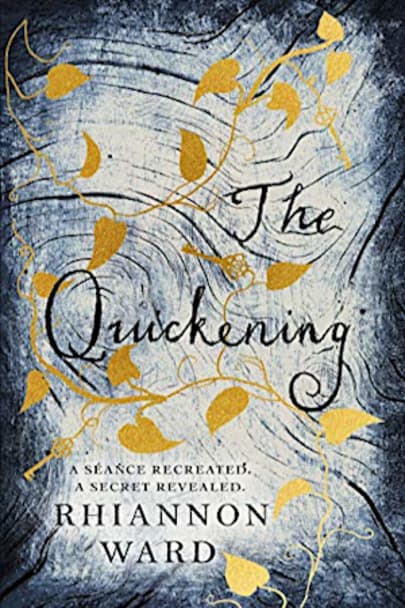‘If you like gothic mystery, buckle up! This atmospheric read has it all’ Woman magazine’An historical novel dripping with menace’Shari Lapena, author of The End of Her********England, 1925. Louisa Drew lost her husband in the First World War and her six-year-old twin sons in the Spanish Flu epidemic of 1918. Newly re-married and seven months pregnant, Louisa is asked by her employer to travel to … employer to travel to Clewer Hall in Sussex where she is to photograph the contents of the house for auction.She learns Clewer Hall was host to an infamous séance in 1896, and that the lady of the house has asked those who gathered back then to come together once more to recreate the evening. When a mysterious child appears on the grounds, Louisa finds herself compelled to investigate and becomes embroiled in the strange happenings of the house. Gradually, she unravels the long-held secrets of the inhabitants and what really happened thirty years before… and discovers her own fate is entwined with that of Clewer Hall’s.For fans of The Silent Companions, The Little Stranger and The Familiars, an exquisitely crafted and compelling mystery that invites the reader in to the crumbling Clewer Hall to help unlock its secrets.*******’Utterly brilliant… full of secrets and deliciously creepy’Lisa Hall, author of The Perfect Couple’A spooky treat, which had me turning the pages faster and faster’Cass Green, author of In a Cottage in a Wood
more



The Quickening by Rhianna Ward is a fantastic gothic novel. For the most part, it’s told from the point of view of Louisa and takes place in 1925. She is a photographer and is offered a job photographing a collection at a crumbling mansion, the longtime home of the Clewer family. A secondary thread takes place in 1896, when an infamous séance took place at the mansion. The gothic tone, setting, backstory and eccentric characters made this novel deliciously unsettling. I found myself unable to put the novel down, dying to know what was going to happen next. I loved the historic details, especially the weird but true ones. Some questions are left unanswered at the end, a nice detail that allows the reader to draw their own conclusions about some of the paranormal elements. Highly recommended for readers who enjoy traditional gothics, especially historic ones.
A ghost story centred around a séance. Set in the aftermath of the First World War, Louisa Drew, herself burdened with great grief, accepts a photography job at Clewer Hall. Louisa, newly (and unhappily) married and in her third trimester, needs the money, but just how much is Louisa’s destiny caught up within the crumbling walls of the mansion and its unhappy inhabitants?
Clewer Hall is a wreck of its former glory; a house, imbued with a ‘sense of malice and spite’ and, from the start, Louisa feels dreadful sense of foreboding and her unborn baby quickens at her increasing sense of unease. The house itself is steeped in tragedy as the family lost three of their boys in the war. The narrative flits between the infamous séance which happened in 1896 and introduces medium Ada Watkins to the narrative. Is she a fraud or did she just get lucky with her premonition that ‘any male child born of the house would die young’? Why does Helene Clewer insist on keeping her around? Ward is skilful in her sympathetic presentation of Ada so that the reader doesn’t dismiss her, despite early passages in the narrative which describe Ada’s arrival at the house. The bulk of the story is voiced by Louisa and recounts her experiences as she photographs the curious exhibits to be sold at auction now that the family are moving to India. At Helene’s bidding they are preparing to re-create the séance of 1896, but why she wants to re-live such a terrifying and miserable event is unfathomable.
This is a place where wearing a mourning brooch on the wrong side of a blouse is to be sneered at. It is a man’s world where there’s nothing wrong with taking a vin mariani (a cocaine tincture) if one is feeling a bit low. In the ominous Adelaide Room, there is fantastical leather wallpaper covered with chimpanzees and snails; a sinister chest full of marbled severed limbs of children, and cats which bite in the dark. And just who is the mysterious person who keeps playing the piano? Ward’s prose is vivid and beautiful with shadows flitting across the lawn, skies heavy with London Particulars – it bursts with the varied scents of rosemary and burnt pine, spiced apples and where the distant salty tang of the sea hangs on the breeze.
The character of Lily is particularly well drawn – she is waspish and, at forty and unmarried, her future happiness is dismal with nothing on the horizon apart from caring for her elderly parents. The dual standards of the aristocracy play out with Conan Doyle’s tolerance of his new wife’s meddling in the afterlife placed alongside his hostility towards Ada’s actions. There is always the nuanced edge of a woman in a cage rippling through the narrative coupled with the spiky atmosphere that the age of service is coming to an end. I enjoyed how the terrifying pieces of the puzzle are slotted together and was truly scared for Louisa at times, but thank heavens for George and his ‘metropolitan gloss’. I read this on the tail of ‘The Haunting of Alma Fielding’ by Kate Summerscale and found they complemented each other perfectly. A beautifully written and absorbing ghostly tale.